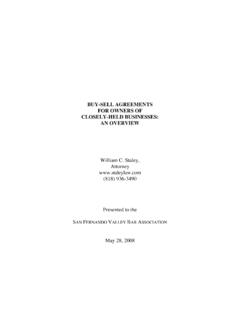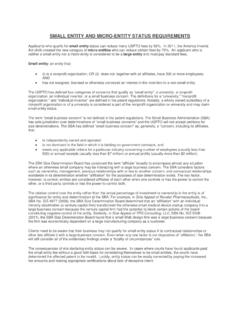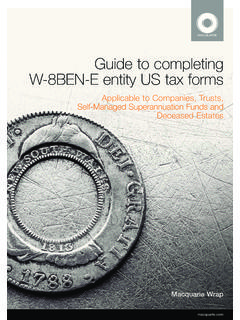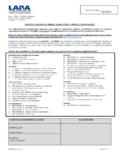Transcription of Choice of Entity for a New Subsidiary of an S Corporation
1 BUSINESS LAW U P D A T E A Publication of the Los Angeles County Bar Association Business & Corporations Law Section Fall 2006 [Article reprint] Choice OF Entity FOR A NEW Subsidiary OF AN S Corporation By William C. Staley Law Office of William C. Staley1 When an S Corporation wants to create a wholly-owned Subsidiary , it has three choices: a C Corporation , a qualified subchapter S Subsidiary (a QSub ) or a limited liability com-pany ( LLC ). This article explains why an LLC is usually the best Choice . Alternative Structures.
2 An existing S Corporation might operate a busi-ness and also own a valuable asset (examples: real estate, art or another business operated as a division). Management will want to insulate the valuable asset from catastrophic claims that might arise in the opera-tion of the Corporation s primary There are various ways to accomplish this: 1 Mr. Staley practices law in Woodland Hills, advising businesses and nonprofit organiza-tions. 2 This would be a judgment that exceeded the value of the Corporation s assets less its (footnote ) The valuable asset could be distributed to the shareholders.
3 This would insulate it, but the sharehold-ers would pay tax on the apprecia-tion in the If the built-in gain tax applied, the Corporation would also pay a Also, it might not be convenient for the shareholders to hold the assets as tenants in com-mon. The S Corporation could form a Subsidiary and transfer the valuable asset to the new Subsidiary . How-ever, a claim against the parent Corporation could be satisfied with the stock of a corporate Subsidiary holding the valuable asset. If the Subsidiary holding the valuable asset is an LLC, the result might be differ-ent.
4 Although a judgment creditor of an LLC member (in this case, the parent Corporation ) is generally lim-ited to a charging order or becom-ing a holder of an economic interest not a voting membership interest in the LLC, many doubt that a judg-ment creditor of a single-member (footnote continued) other liabilities and also its insurance cover-age. 3 311. 4 1374. BUSINESS LAW U P D A T E 2 LLC would be prevented from ob-taining the LLC s The primary business could be transferred to a Subsidiary and the valuable asset could be held in the parent This would be satisfactory if the valuable asset was art or another asset that would not generate liabilities, because the sub-sidiary stock would be subject to claims against the parent corpora-tion.
5 To preserve the benefits of S Corporation status7 the parent must 5 Cal. Corp. Code 17302 (no charging or-der exception for single-member LLCs); but see In re A-Z Electronics, 2006 Bankr. LEXIS 2105 (Bankr. D. Idaho, February 23, 2006) (bankruptcy trustee of sole member and not member-manager entitled to file bank-ruptcy petition on behalf of the LLC); In re Albright, 291 538 (Bankr. D. Colo. 2003) (allowing a bankruptcy trustee to reach the assets in the debtor s single-member LLC). See also J. Stein, Building Stumbling Blocks, BUSINESS ENTITIES (September/October 2006) 28, 34-36.
6 6 This could be accomplished by creating a new Corporation and issuing its shares to the existing shareholders in exchange for their shares of the existing Corporation . The old Corporation would become a Subsidiary of the new Corporation . The Subsidiary would distribute its valuable asset to the parent Corporation . 7 The principal benefit of S Corporation status is the ability to sell the business assets and to pay one level of tax, with the goodwill taxed as capital gain so that the favorable tax rates for long-term capital gain can apply. An S Corporation that is not subject to the built-in gain tax can accommodate the buyer s wish to buy assets (not stock) without creating a double tax for the selling share-(footnote ) elect to be an S Corporation and must elect to treat the old corpora-tion/new Subsidiary as a A QSub is disregarded for tax purposes and its assets are treated as assets of its S Corporation Because the QSub is disregarded for tax (but not liability)
7 Purposes, it could be merged into a limited liability company wholly-owned by the par-ent Corporation . A single-member LLC is also disregarded for federal tax Consequently, this merger would have no effect for federal tax purposes the assets and liabilities of the parties to the merger would be the assets and liabilities of the parent (for tax purposes) before and after the merger. A new holding company could be organized with two sub- (footnote continued) holders.
8 For a mature business with substan-tial cash flow, S Corporation status allows the business to distribute profits to shareholders with one level of tax. 8 1361(b)(3)(B); Treas. Reg. 9 1361(b)(3)(A); Treas. Reg. (a). Because the separate existence of the QSub is disregarded, the transfer of assets between the parent and Subsidiary has no effect for tax purposes. To avoid piercing the corporate veil, the transfers must be properly documented and properly re-flected on the accounting records of both entities. 10 Treas. Reg. (b)(1) (the check-the-box rules for Entity classification for federal tax purposes).
9 BUSINESS LAW U P D A T E 3 sidiaries: the existing Corporation and a new Subsidiary . The existing Corporation would transfer its valu-able asset to the new Subsidiary . The holding company would own only the stock or other ownership interests in the subsidiaries. A claim against one Subsidiary could not be satisfied with the stock or assets of the other Subsidiary or with the stock or assets of the holding C Corporation . In these examples the subsidiaries hold valuable assets and businesses. If the value of the asset or business exceeds its tax basis or is likely to exceed its tax basis in the future it generally should not be held in a C Corporation .
10 When the asset is sold by a C Corporation , the Corporation will pay tax on the gain and the shareholders will pay tax again when the after-tax sale pro-ceeds are distributed to them. This rules out a C Corporation as a sub-sidiary in many So the 11 In this article we assume that the entities would be organized and operated in way that would prevent a creditor from piercing the corporate veil of any Entity . 12 If the parent Corporation is a C corpora-tion not what we assume in this article it might make sense for its Subsidiary to be a C Corporation and to use the consolidated return rules and the dividends-received de-duction to minimize taxes on transfers within the consolidated group.









